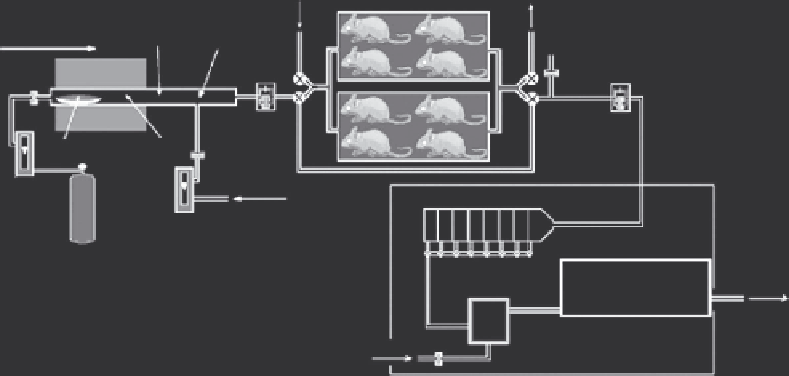Environmental Engineering Reference
In-Depth Information
membranes (protein-mediated transport). However, the translocation from the alveolar region to the
blood circulation depends essentially on size. Thus, the 80 nm particles translocate about one order
of magnitude less effectively than the 20 nm ones. The micron-sized particles are excluded from
this transportation because of their large size. Also, since microparticles are rapidly phagocytosed
by lung surface macrophages, they are only shortly available for protein-mediated transport (Geiser
and Kreyling, 2010). Thus, alternative ways of particle synthesis are to be developed for generation
of nanosized medical particles with high concentration. The promising route seems to be the homo-
geneous nucleation from supersaturated vapor.
Approximately one third of the modern drugs are water-insoluble or poorly water-soluble. Many
currently available injectable formulations of such drugs can cause side effects that originate from
detergents and other agents used for their solubilization. Besides, water-solubility problems delay or
completely block the development of many new drugs and other biologically useful compounds. Thus,
the lung deposition route can be a good alternative for the administration of poorly soluble substances.
Nonsteroid anti-inlammatory drugs (NAD) like indomethacin and ibuprofen which have low water
solubility are considered for the lung delivery (Rabinowitz and Zaffaroni, 2004). Indomethacin is a
well-known drug for use against a wide range of diseases such as rheumatoid arthritis, spondylosis,
and chondrosis. Ibuprofen is a nonsteroidal, chiral, anti-inlammatory drug that inhibits the enzyme
cyclooxygenase and thus acts as an analgesic (Meade et al., 1993). It is most often prescribed to
treat rheumatoid arthritis and pain. However, the side effects from these medicines can cause serious
disorders such as bleeding and perforation of gastrointestinal tract, depression, drowsiness, mental
disorder, increased blood pressure, congestive heart failure etc. One can hope that the aerosol lung
administration of NAD may be an alternative route which would diminish side effects and decrease
the therapeutic dose. However, new side effects like pulmonary emphysema are possible. Therefore,
it is necessary to estimate both the therapeutic beneits and possible risks of aerosol administration.
In this chapter we study the evaporation-condensation formation of indomethacin and ibuprofen
nanoparticles and its anti-inlammatory and analgesic effects, as well as side effects on outbred
male mice.
11.1.2 s
yntHesis
oF
n
anoaerosol
The inhalation scheme includes a low aerosol generator, inhalation chambers for mice, il-
ters, diluters, low control equipment and aerosol spectrometer (Figure 11.1). The horizontal
Air
Supersaturated
vapor
Flow direction
Nucleation
Filter
Heater
Diluter
Diluter
Filter
Maternal
substance
Saturated
vapor
Filter
Diluting
air
Flow
control
Diffusion battery
Ar
Flow
control
Nucleation
chamber
Photoelectric
counter
Filter
Air
Aerosol spectrometer
FIGURE 11.1
Scheme of the experimental set-up for inhalation experiments.

Search WWH ::

Custom Search